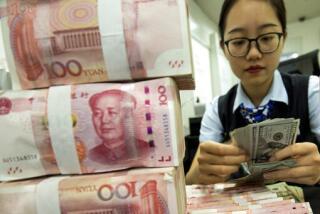Manufacturers Hanover Deal Opens U.S. Banking to Dai-Ichi Kangyo Bank
- Share via
Dai-Ichi Kangyo Bank on Monday disclosed that it would make the largest single move by a Japanese financial institution into American banking by spending $1.28 billion for a majority stake in Manufacturers Hanover Corp.’s CIT Group, a business-lending unit.
In addition, Dai-Ichi Kangyo will spend $120 million for a 4.9% stake in the New York bank itself.
Separately, Manufacturers Hanover said it will boost by $950 million its reserves that cushion it against problem loans to developing countries, primarily in Latin America. As a result, the bank said, it expects to post a loss of $775 million in the third quarter and $475 million for the year.
For Dai-Ichi Kangyo, the world’s largest bank, the purchase of 60% of CIT Group and the small stake in Manufacturers Hanover represents its first major move into the U.S. banking market. The Tokyo-based bank, which had $415 billion in assets as of March 31, has been surprisingly slow to enter the U.S. market while some of its Japanese competitors have done so aggressively.
Bought From RCA
Other Japanese banks with a major presence include Mitsubishi Bank, which owns Bank of California in San Francisco; Sanwa Bank and Sumitomo Bank, which have major operations in California; Bank of Tokyo, which owns Union Bank in San Francisco, and Mitsui Bank, which is forging close ties to Security Pacific Corp. in Los Angeles. In a separate announcement Monday, Daiwa Bank of Japan agreed to buy the U.S. commercial banking business of Lloyds Bank of Great Britain for $200 million.
CIT, which Manufacturers Hanover bought from RCA in 1984 for $1.5 billion, provides loans mostly to medium-sized businesses. It has assets of more than $9.7 billion. Last week, Manufacturers Hanover confirmed that it was negotiating to sell a stake in the operation to Dai-Ichi Kangyo.
The moves by Manufacturers Hanover are part of a broad, four-part plan announced by the bank to strengthen its capital position and offset its Latin American loans.
Overall, it plans to raise as much as $620 million through the sale of stock. It plans to sell up to $500 million in new common stock to the public. In addition, it is selling 2.7 million shares for $45 each to Dai-Ichi Kangyo. As part of the stock sale, Dai-Ichi Kangyo agreed not to buy more Manufacturers Hanover stock for 10 years.
Manufacturers Hanover Chairman John F. McGillicuddy said in a statement that recent debt negotiations with Mexico and the U.S. government’s plan for cutting the Third World’s $1.3-billion debt, called the Brady Plan after Treasury Secretary Nicholas F. Brady, contributed to the decision to increase its reserves. Those moves are expected to make it harder for banks to collect outstanding loans.
Lagged in Past
Banks are facing increasing pressure to raise their reserves on their Latin American debt. British banks recently raised their reserves to 50%. In addition, some American bankers believe that regulators at the Federal Reserve and the Office of the Comptroller of the Currency may pressure banks to increase reserves.
James J. McDermott Jr., an analyst in New York who follows Manufacturers Hanover for Keefe, Bruyette & Woods Inc., said the move by itself is unlikely to trigger other banks to add to their reserves immediately because Manufacturers Hanover in the past has lagged behind other major banks doing so.
Manufacturers Hanover is raising its reserves to $2.4 billion of its $6.8-billion medium- and long-term loan portfolio to developing nations. That means Manufacturers Hanover now has reserves totaling 36 cents for each dollar that it has provided less developed countries, compared to 22 cents for each dollar before. The vast majority of its foreign loans are to Mexico, Brazil, Venezuela, Argentina and Chile.
Last week, Citicorp Chairman John S. Reed told securities analysts that he is comfortable with Citicorp’s level of reserves for its loans to developing countries, although he left open the possibility that it may add to them soon.
Management to Remain
Bank of America, with reserves totaling about 37% on its medium- and long-term debt of $7.4 billion to developing countries, declined to comment on whether the move by Manufacturers Hanover would affect its reserves.
Both Manufacturers Hanover and Dai-Ichi Kangyo sought to emphasize that CIT would continue to operate normally, despite the change in control. The management will remain, with Albert R. Gamper Jr. as CIT’s chief executive.
Despite its size, Dai-Ichi Kangyo could face problems making the CIT investment work. Some bankers wondered whether it may have an experience similar to Fuji Bank Ltd.’s 1984 purchase of Walter E. Heller & Co., a Chicago finance firm troubled with bad loans to small and medium-sized businesses.
COMPANIES AT A GLANCE Manufacturers Hanover
Year ended Dec. 31 1988 1987 1986 Sales (billions) $8.5 $7.6 $7.9 Net income (loss) (billions) $0.95 ($1.1) $0.038
Headquarters: New York Assets: $71.9 billion Employees: 22,786 Offices:: 400 worldwide 52-week range: $26.25-$44.125 Monday close (NYSE): $41.75, up 87.5 cents Dai-Ichi Kangyo Assets: $415 billion Deposits: $315 billion Offices: 453 worldwide Employees: 18,000
More to Read
Inside the business of entertainment
The Wide Shot brings you news, analysis and insights on everything from streaming wars to production — and what it all means for the future.
You may occasionally receive promotional content from the Los Angeles Times.







